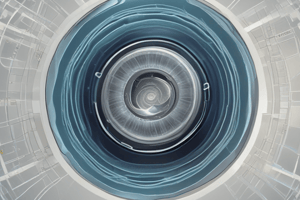Podcast
Questions and Answers
What can happen to the opposite ureter in children with a large ureterocele?
What can happen to the opposite ureter in children with a large ureterocele?
- It remains unaffected
- It becomes obstructed (correct)
- It becomes more prominent
- It becomes smaller
What is a characteristic of ureteroceles in terms of symmetry?
What is a characteristic of ureteroceles in terms of symmetry?
- They are always symmetrical
- They are seldom symmetrical (correct)
- They are never symmetrical
- They are usually symmetrical
What is the location of the content being described in the context of ureteroceles?
What is the location of the content being described in the context of ureteroceles?
- Urethra
- Ureter
- Kidney
- Bladder (correct)
What imaging technique is likely to be used to diagnose ureteroceles?
What imaging technique is likely to be used to diagnose ureteroceles?
What is the term for a condition in which the ureter is obstructed?
What is the term for a condition in which the ureter is obstructed?
What is the relationship between the size of the ureterocele and the obstruction of the opposite ureter?
What is the relationship between the size of the ureterocele and the obstruction of the opposite ureter?
What is the anatomical structure that is most closely related to the ureterocele?
What is the anatomical structure that is most closely related to the ureterocele?
What is the term for the condition in which the ureter is abnormally dilated?
What is the term for the condition in which the ureter is abnormally dilated?
What is the primary reason for ensuring the bladder is full before an ultrasound imaging procedure?
What is the primary reason for ensuring the bladder is full before an ultrasound imaging procedure?
Which of the following symptoms is NOT an indication for ultrasound imaging of the urinary bladder?
Which of the following symptoms is NOT an indication for ultrasound imaging of the urinary bladder?
What is the primary goal of ultrasound imaging in patients with hematuria?
What is the primary goal of ultrasound imaging in patients with hematuria?
In which of the following situations is ultrasound imaging of the urinary bladder NOT typically performed?
In which of the following situations is ultrasound imaging of the urinary bladder NOT typically performed?
What is the relationship between the fullness of the bladder and the visualization of the pelvic organs?
What is the relationship between the fullness of the bladder and the visualization of the pelvic organs?
Which of the following is a potential complication of recurrent urinary tract infections?
Which of the following is a potential complication of recurrent urinary tract infections?
What is the primary difference between indications for ultrasound imaging of the urinary bladder in adults and children?
What is the primary difference between indications for ultrasound imaging of the urinary bladder in adults and children?
What is the role of ultrasound imaging in the evaluation of pelvic mass?
What is the role of ultrasound imaging in the evaluation of pelvic mass?
What is a common cause of bladder distension in males?
What is a common cause of bladder distension in males?
What can cause a small bladder in a patient with a clinical history of frequent and painful micturition?
What can cause a small bladder in a patient with a clinical history of frequent and painful micturition?
What is a common symptom of an enlarged prostate?
What is a common symptom of an enlarged prostate?
What can cause a small bladder in a patient with a clinical history of frequent but not painful micturition?
What can cause a small bladder in a patient with a clinical history of frequent but not painful micturition?
What is a common complication of bladder distension?
What is a common complication of bladder distension?
What is the purpose of asking the patient to empty the bladder and rescan?
What is the purpose of asking the patient to empty the bladder and rescan?
What is a common cause of bladder distension in females?
What is a common cause of bladder distension in females?
What is the purpose of giving the patient more fluid and asking them not to micturate, then rescanning in 1-2 hours?
What is the purpose of giving the patient more fluid and asking them not to micturate, then rescanning in 1-2 hours?
Flashcards are hidden until you start studying
Study Notes
Ultrasound Imaging of the Urinary Bladder
- Indications for ultrasound imaging of the urinary bladder include:
- Dysuria or frequency of micturition
- Hematuria (after bleeding has stopped)
- Recurrent infection (in adults; acute infection in children)
- Pelvic mass
- Retention of urine
- Pelvic pain
Preparation of the Patient
- The bladder must be full during the ultrasound examination
Normal and Abnormal Urinary Bladder
- A normal bladder appears as a smooth, evenly stretched structure
- Columns within the bladder indicate a possible ureterocele, which may be bilateral but rarely symmetrical
- Large/overdistended bladder:
- Bladder walls will be smooth and evenly stretched, with or without diverticula
- Measurements can confirm suspected overdistension
- Always check the ureters and kidneys for hydronephrosis
- Ask the patient to empty the bladder and rescan to see if it is completely empty
- Common causes of bladder distention include:
- Enlargement of the prostate
- Urethral stricture in the male
- Urethral calculus in the male
- Bruising of the urethra in the female ("honeymoon urethritis")
- Neurogenic bladder from damage to the spinal cord
- Small bladder:
- May be due to cystitis, which prevents the patient from holding urine and causes frequent and painful micturition
- May be due to damaged or fibrosed bladder walls, reducing bladder capacity
- May be due to other causes, such as urethral valves or diaphragm in newborn infants, or cystocele in some patients
Studying That Suits You
Use AI to generate personalized quizzes and flashcards to suit your learning preferences.




